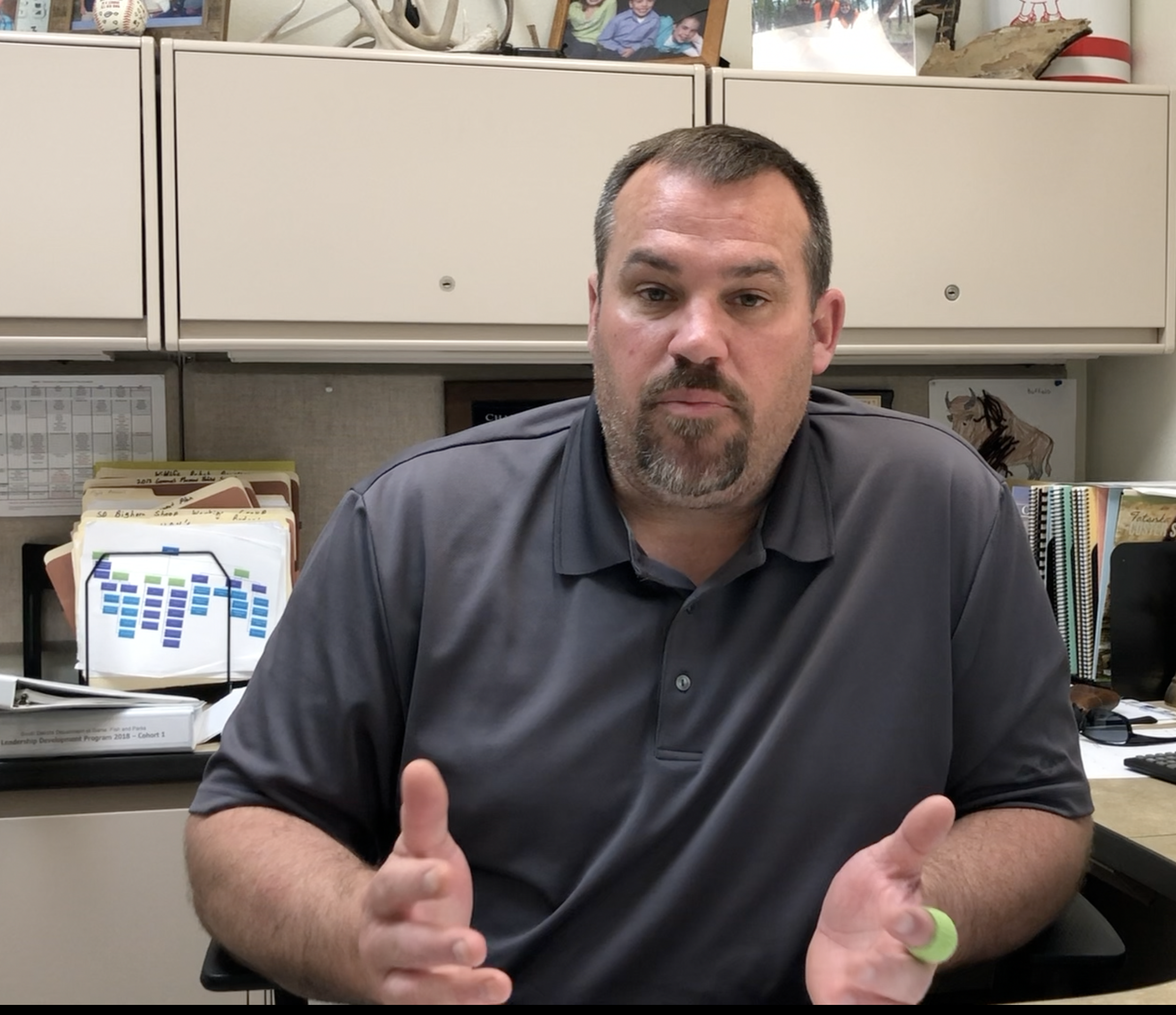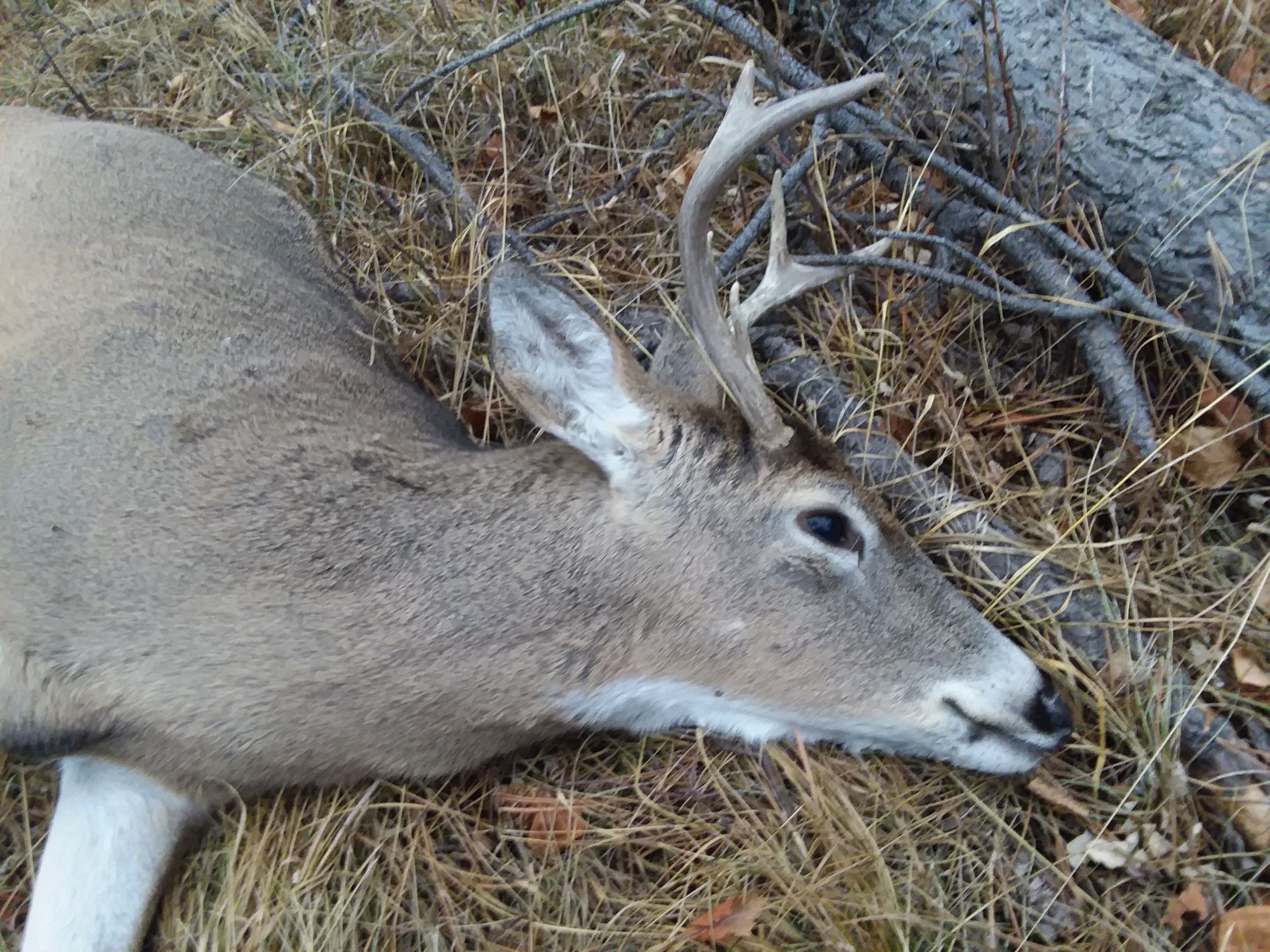The discovery in March that a rocky mountain elk tested positive for Chronic Wasting Disease in Clark County — the easternmost case ever found in South Dakota — has provided scientists further evidence that the deadly disease is continuing to spread across the state.
The diagnosis comes as new research shows that CWD may be causing some North American deer and elk herds to shrink and has heightened concerns the disease could jump species and begin to kill other animals, including humans. So far, there is no evidence that the contagious disease can be spread to humans, though consuming meat from an infected deer is not advised.
CWD causes deer, elk, moose and caribou to literally waste away. The disease causes an infected animal’s brain tissue to break down and become sponge-like. As the brain breaks down, the animal loses some survival instincts and eventually loses the ability to feed itself.
The Centers for Disease Control, National Institute for Health and the South Dakota GFP all recommend that people should not eat any animal that looked sick before it was killed or which tested positive for any disease.
“This is a scary disease,” said Chad Switzer, wildlife program administrator for the South Dakota Game Fish & Parks Department. “Knowing what I know about the disease, if I harvested a deer from an endemic area, I would have it tested.”
In addition to causing deer and elk to endure a slow death, CWD has a direct impact on hunting and could harm the state outdoors economy.
In South Dakota, deer hunters spent more than $160 million in the state in 2016, according to an economic analysis by the state Game, Fish & Parks Department. About 70,000 South Dakotans hunt deer and drive an industry with about 3,900 jobs and $125 million in wages across the state.
“Everyone in the state should have a stake in this,” said GFP big-game Biologist Steve Griffin. “It’s about our deer.”
The new case in Clark County, located west of Watertown, was also the first time in more than 15 years that a deer or elk in one of the state’s 70 captive deer facilities had tested positive for the disease. How the elk caught the disease is still a mystery, but an investigation is ongoing, said state Veterinarian Dustin Oedekoven.
Officials have not found any wild deer with CWD in Clark County. But the state has stepped up its monitoring for sick deer in the area and plans to notify deer hunters about the discovery before the next hunting season this fall.
Switzer has been leading a GFP effort to create a new plan for how to deal with the disease in the state wild deer and elk populations. South Dakota wildlife managers plan to get more aggressive both in their monitoring of the disease and in efforts to control its spread. In early July, the state Game Fish & Parks Commission will be presented a new Chronic Wasting Disease Action Plan and consider a set of proposed regulations aimed at better monitoring and controlling the spread of CWD.
The proposals have not been released to the public, but Switzer said he expects them to include restrictions on movement of whole deer carcasses, heads and spinal columns from areas and states known to have CWD. Exceptions would be granted for people taking deer directly to a taxidermist or meat processor.

Contagious and concerning
Obvious symptoms of CWD don’t show up until the latest stages of the disease. Most hunters and wildlife watchers wouldn’t be able to tell if a deer or elk was infected just by looking. Even in the later stages, CWD symptoms are similar to a variety of deer diseases.
If a hunter or anyone else sees a deer that looks sick, they should report it to GFP.
According to the CDC, a hunter’s risk of contracting the disease is “extremely small, if it exists at all.”
The CDC has also said that “it is extremely unlikely that CWD would be a food-borne hazard.”
In South Dakota hunters can voluntarily submit a sample form their deer or elk for CWD testing by contacting the GFP. Switzer said test results are typically available within five to 10 days of submission and the hunter is notified of the results via mail.
Despite the minimal risk, public health officials recommend against eating a deer or elk that tests positive for CWD, while they continue to investigate potential health risks.
CWD is not caused by a bacteria or a virus; rather, it is known as a “prion disease” caused by a malformed protein that causes other proteins to deform. The disease group of TSE, or transmissible spongiform encephalopathies, includes scrapie, which affects sheep, as well as bovine spongiform encephalopathy, also known as Mad Cow Disease. Another TSE, Creutzfeldt Jakob’s Disease, can affect humans.
All TSEs share a few key characteristics. They’re all contagious and they all cause brain tissue to break down, which leads to behavioral changes. Scrapie, for example, got its name by causing sheep to scrape themselves until bloody.
Steve Griffin, a state big game biologist in Rapid City, has helped shape GFP efforts to monitor CWD. He said it can take years before the disease symptoms start to become obvious. Less obvious symptoms such as slower reaction times and being a little bit less aware opens a deer up to predation from coyotes and mountain lions. Most people who spend time watching or hunting deer would not be able to tell is a deer is infected.
“Most of the time, an animal won’t die of CWD,” Griffin said. “It’ll get pneumonia or will be killed by a predator.”
The long incubation period is one reason CWD is hard to track. Clinical research on the disease can take years to get results.
“It’s really hard to study,” said Alan Young, an animal disease researcher at South Dakota State University.
The prions that cause CWD are hard to destroy. They can bind to clay particles in soil and stay there, absent a living host, for years. Prions also have been shown to resist heat up to 1,800 degrees Fahrenheit and are thought to resist most sterilizing chemicals.
Young studied the disease for almost a decade. The difficulty researchers have had in studying the disease, coupled with sometimes scant funding means there’s still a lot that science doesn’t know about CWD. “There’s no clear answer on any of it,” Young said.
The prevailing science surrounding CWD says that once a deer catches it, the deer dies. But unlike other deer diseases that can be fatal in days, CWD can take years to kill. That means the disease lingers in populations and often goes unnoticed without testing.
A 2016 study in Converse County, Wyoming found that at above a 20 percent infection rate, the county’s mule deer herd started to shrink. A similar study on elk in Colorado found that at 13 percent prevalence rates, herds might become unsustainable.
“You basically lose all hunting in those areas,” Griffin said.
Another important factor is that wildlife management in South Dakota, much like the rest of the United States, is largely supported by the sale of hunting licenses. More than half of the GFP Wildlife Division annual budget of $56 million is funded by license sales. The rest came from federal excise taxes paid on guns, ammunition, archery equipment, fishing gear and boat fuel.
If deer numbers fall and hunting is restricted, less money would be available to manage wildlife populations and habitat.
While most of the concern lies with CWD’s effect on deer, there is some worry the disease could jump the species barrier. So far, that hasn’t happened in more than 50 years of study.
“We just don’t have any evidence that CWD has jumped species,” Oedekoven said.
Researchers have been watching for a species jump, however. In 2017, a group of Canadian researchers claimed to have infected macaque monkeys with CWD.
But in 2018, researchers from the U.S. National Institutes of Health published a study in which they were unable to infect macaques with CWD, no matter what they tried, including injecting CWD prions into monkey brainstems.
Yet Mad Cow Disease is thought to have jumped the species barrier during the early 1990s in Great Britain. More than 200 people were diagnosed with a disease called variant Cruetzfeldt Jakob’s Disease after eating beef that had tested positive for Mad Cow Disease.
The sheep prion disease, scrapie, has been known to infect sheep for about 200 years. To date, no human has been known to have been infected with the disease. Scrapie just isn’t a human health concern, Oedekoven said.

New action plan on the way
In 1997, a captive elk died and tested positive for CWD on a farm in the Black Hills. The South Dakota Animal Industry Board traced the animal’s origin and eventually found seven other CWD-positive animals. Most were in or near the Black Hills but one was found in McPherson County, northwest of Aberdeen.
After the 1997 discovery, GFP aggressively tested wild elk and deer killed near the captive herds. There were no new cases discovered. In 2001, the first wild deer tested positive for CWD. Since then GFP has tested 27,549 deer, elk and moose for CWD. Of those, 425, or less than 2 percent, came back positive.
Most of that testing was done before 2012, when the U.S. Department of Agriculture cut funding for a program that helped states monitor and manage the disease both in captive and wild populations. Since then, the state has relied on hunters to voluntarily submit deer and elk for testing.
In light of new research and to catch up with national best practices, the GFP in June 2018 embarked on a year-long project to develop a CWD action plan.
Switzer said drafting the action plan has been deliberately slow. It started with GFP big-game biologists reviewing the available science. Switzer then put together a group of hunters, taxidermists, and meat processors to help. Switzer also led a series of public meetings around the state to educate hunters or anyone else with an interest in CWD.
The plan hasn’t been finalized but a draft is scheduled to be presented to the Game, Fish & Parks Commission at its July meeting in Fort Pierre. If the commission agrees to consider the plan for adoption, it will be opened up to public comments for about 60 days. The Commission would take a formal vote to adopt the plan during its September meeting in Spearfish.
In addition to carcass movement restrictions for hunters, the plan may also change how taxidermists and meat processors dispose of deer remains.
Taxidermists will be asked to get trained in gathering samples from deer for testing. Meat processors may also be asked to help gather samples.
“The key point is, we’re looking at the human movement,” Griffin said.
What likely won’t get any attention is the well-intentioned feeding of wildlife, Switzer said. It’s a big problem, one that likely contributes to the spread of CWD but the backlash against banning or even severely limiting wildlife feeding could derail department efforts to build support for its work to slow the spread of CWD.
“Some would argue it’s more appropriate to work with the legislature first,” Switzer said of banning wildlife feeding.
The South Dakota Animal Industry Board regulates deer and elk farms through a permitting system. For about a decade, any time a captive deer or elk was diagnosed with CWD, the entire herd was destroyed. The USDA paid the owner for the loss under the program that ended in 2012.
Oedekoven said the fear surrounding Mad Cow Disease had started to wane, and funding for animal prion disease research and control began to dry up.
A 2012 partnership between the USDA, state agencies and the deer and elk farming industries implemented a national voluntary herd certification program requiring anyone who wants to move deer between states to have animals tested and certified as CWD-free.
“No animal can come into the state that isn’t from a certified herd,” Oedekoven said.
The certification program is not foolproof. The elk that tested positive for CWD in March at the farm in Clark County was brought in from a certified herd, Oedekoven said.
There are about 70 captive deer operations in South Dakota, raising everything from reindeer to muntjac, a small Asian deer with fangs. Mostly, farmers are raising white-tailed deer and rocky mountain elk.
Many operations do not move animals out of state, so they are not subject to herd testing rules, Oedekoven said.
Nationally, deer farmers are working on breeding deer and elk that are genetically resistant to CWD, said Shawn Schafer, executive director of the North American Deer Farmers Association. A similar effort was made for sheep and scrapie, he said.
“If we can figure out the genetics,” Schafer said, “If we can do that, it’s a non-issue for us.”
At the same time, the organization has been pushing for increased federal funding to study CWD and help control its spread.

Battling CWD at the ground level
Derick Wenk has a long love affair with deer.
He’s a lifelong deer hunter and spent part of his childhood looking after captive deer and elk owned by his dad. He has also built a business around deer as a taxidermist.
While Wenk has a vested interest in South Dakota’s deer population, he’s not quite sure how to think about CWD.
“It’s scary,” Wenk said, “But if it was going to kill everything, I think we’d have seen something by now.”
Still, as president of the South Dakota Taxidermists Association, he was a member of the GFP workgroup that helped shape the state CWD action plan. He said he’s more than happy to help GFP monitor the disease, even if it means learning how to take tissue samples from deer his clients bring him.
“If you’re smart, you realize you want to be proactive,” Wenk said.
That kind of buy-in from hunters and the general public will be critical if the spread of CWD is to be slowed, Switzer said. One of the biggest things hunters can do to slow CWD’s spread is to properly dispose of deer carcasses, he said. The easiest way to do that is to take them to permitted landfills, which can be found on the GFP website.




